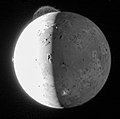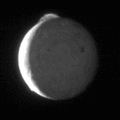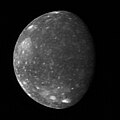File:NewHorizonsIo.jpg
Appearance
NewHorizonsIo.jpg (330 × 326 pixels, file size: 24 KB, MIME type: image/jpeg)
File history
Click on a date/time to view the file as it appeared at that time.
| Date/Time | Thumbnail | Dimensions | User | Comment | |
|---|---|---|---|---|---|
| current | 23:36, 22 December 2022 |  | 330 × 326 (24 KB) | Ras67 | == {{int:filedesc}} == {{Information |Description={{en|1=Image of Io taken by New Horizons on February 28, 2007. * This dramatic image of Io was taken by the Long Range Reconnaissance Imager (LORRI) on New Horizons at 11:04 Universal Time on February 28, 2007, just about 5 hours after the spacecraft's closest approach to Jupiter. The distance to Io was 2.5 million kilometers (1.5 million miles) and the image is centered at 85 degrees west longitude. At this distance, one LORRI pixel subtends... |
File usage
The following page uses this file:
Global file usage
The following other wikis use this file:
- Usage on af.wikipedia.org
- Usage on hr.wikipedia.org
- Usage on it.wikipedia.org
- Usage on ko.wikipedia.org
- Usage on lt.wikipedia.org
- Usage on no.wikipedia.org
- Usage on pt.wikipedia.org
- Usage on sh.wikipedia.org
- Usage on th.wikipedia.org
- Usage on vi.wikipedia.org
- Usage on zh.wikipedia.org












